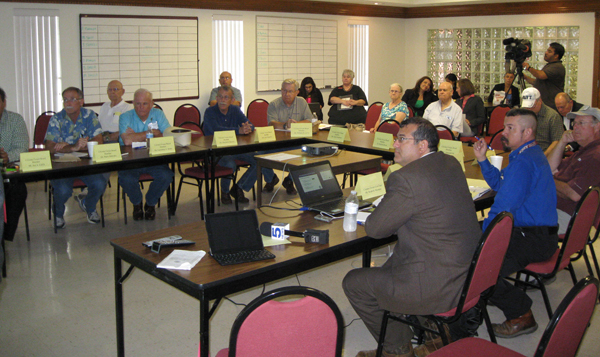- La Feria Community Holds Succesful Business Mixer Event
- Little Nashville to Take Place in Downtown Mercedes
- Lions Basketball Captures District Gold
- La Feria ISD Students Compete in Regional Chess Tournament
- Lions End First Half of 32-4A on a High Note
- La Feria ISD Held Another Successful Parent Conference
- Strong Appearance for Lions at Hidalgo Power Meet
- LFECHS Students Get to Meet Local Actress
- Students Participate in Marine Biology Camp
- Two LFECHS Students Qualify for All-State Band
USIBWC Citizens Forum Updates Current Flood Control Status
- Updated: June 12, 2015

Bill Keltner
The May 2015 meeting of the Lower Rio Grande Citizens Forum was a progress report on the current status of the Rio Grande and preparations being made for water management should the Valley face flooding from any named tropical storms this approaching hurricane season. This concern was evident as the USIBWC officers described what has been done along the Rio Grande and the Arroyo Colorado. The Rio Grande from El Paso to the mouth of the river is managed by the United States Section of the International Boundary and Water Commission (USIBWC). The meeting was conducted in the agency’s public conference room at the Mercedes main headquarters.
Citizens Forum Co-Chair Omar Rios got the meeting got underway with a welcome and introductions of concerned citizens and members of the press. This public meeting attracted a room full of concerned attendees from such diverse fields as environmentalists, park rangers, law enforcement, farmers, and city managers–all with deep concern about flooding and the availability of water for their needs.

Public Forum presenters: William Don Finn, USIBWC Chief and Civil Engineer Ramon F. Navarro.
Ramon F. Navarro, a Civil Engineer with the USIBWC was the first speaker. He led the Upper Brownsville Levee Geotechnical site investigation in Cameron County. His remarks concerned the three major cracks that appeared on the levee downstream of the Gateway International bridge. These cracks appeared in March of 2014. They were an immediate major concern to both sides of the river. The safety of the bridge and levees was the concern.
Navarro showed slides and described how the investigative soil borings were collected from the sites and given a laboratory analysis to determine how to repair the problem. The scientists also measured channel erosion and sediment deposits in a science called bathymetry. This information was turned over to the United States Army Corps of Engineers who have since done the necessary work to strengthen the levee.

Audience gets water management update.
“Right now,” he said to the concerned audience, “those cracks that appeared have been corrected, and they pose no immediate flood risk.”
William Don Finn, Chief, Water Accounting Division, USIBWC, centered his remarks on the update status on Mexico’s Five-Year Rio Grande water deliveries agreement to the United States.
He reviewed the 1944 Water Treaty with Mexico. In that treaty Mexico is required to deliver water into the Rio Grande from six tributaries during five-year cycles. Among those Mexican rivers are the major rivers: Rio Conchos, Arroyo las Vacas, Rio Alamo and Rio San Juan. They all deliver water upstream of the Amistad and Falcon dams.
“The current 5-year cycle runs until October 2015,” he said, adding, “right now, they are behind. If they fail and Mexico does not deliver, then their deficit can be made up in the next 5-year cycle according to the agreement between the two countries.” He added that there has been a lot of beneficial rain both in Mexico and the United States that is helping relieve the shortage of water for both countries. We also need to see what the tropical storm season brings that might change the game.

Local USIBWC Manager Rodolfo Montero handled the follow-up public comment and question session. Plans were made for the next public meeting of the LOWER RIO GRANDE CITIZENS FORUM later in the year.
Anyone wanting more information about the next meeting and has a desire to attend can call Montero at 956-565-3150.


